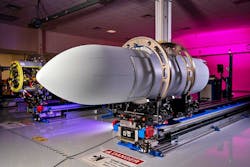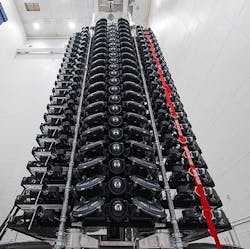Despite Supply-Chain Disruptions, the Microwave Industry Powers Ahead
This article is part of the TechXchanges: Chip Shortages and Counterfeits, Defense Electronics, and Automotive Radar.
What you’ll learn:
- Pandemic-driven shutdowns and Chinese tariffs caused a ripple effect to the supply chain.
- Defense electronics suppliers have had to get creative to keep production on track.
- Smart-home/IoT device production has likewise been adversely impacted.
The supply-chain issues that affected many industries in recent years have also had a significant impact on the RF and microwave industry. The shortage of semiconductors and other components led to production delays, increased prices, and reduced innovation. Despite the challenges, the industry will continue to grow in the coming years, driven by greater use of RF and microwave technologies in applications ranging from 5G and IoT to satellite communications and defense systems.
Nonetheless, the industry hasn't been immune to disruption. As a distributor of RF and microwave components and subsystems, RFMW has a wide-angle perspective of the broader RF/MW market and its myriad of customers because it serves not just itself, but the dozens of companies whose products it sells. From this vantage point, RFMW has seen and continues to see the consequences of what’s occurred since 2020.
It hasn't been easy. First came the pandemic in early 2020 that caused factories in China and other countries to shut down or reduce production, after which the U.S. imposed tariffs on Chinese goods, including electronics components. Then, around September 2020, the demand for all types of components surged, driven by people working from home or school. And to make matters worse, severe winter storms in Texas damaged factories, and a drought followed in Taiwan.
The result of all this has been a frantic back and forth between supply and demand, with prices increasing, then decreasing, then increasing again, and so forth. It’s also caused companies to place orders for large numbers of devices to ensure supply, only to decide later that they don’t need them for some reason. This further contributes to issues that disrupt the supply chain and needlessly prolong the problem.
All of this has occurred as the wireless industry tries to deploy 5G infrastructure, the satellite broadband industry continues to launch more satellites, and vehicles become wirelessly connected. The defense industry is faced with trying to supply Ukraine with electronic warfare, electronic countermeasures, radar, and air defense and communications systems while attempting to replenish resources at home.
Such systems rely on RF and microwave components from passives to discrete semiconductors and MMICs, integrated microwave assemblies, and multifunctional solutions driven by software-defined radios that combine analog and digital devices in a single package.
Delays in Defense System Production
The defense industry has been hit rather hard by the shortage of RF and microwave components because they’re foundational components of so many platforms (Fig. 1). The shortage has led to production delays, increased costs, and even shortages of some critical military equipment. In several cases, the Department of Defense was forced to delay or cancel projects.
For example, the Navy's Littoral Combat Ship program has been delayed by several years due to the shortage of RF and microwave components, and the Air Force F-35 Joint Strike Fighter program felt the impact as well, with some aircraft supplied without critical components. The Army's Abrams tank program has been affected by the shortage, too, with some tanks being delivered without the latest communication systems.
Military electronics suppliers, from printed-circuit-board makers to prime contractors and system integrators, are pivoting from traditional procurement practices to accommodate the reality of today's markets. In short, they must get creative and find new ways to source components and materials and manufacture and evaluate their products.
Another sector severely hit by RF and microwave device shortages is the automotive industry. These are the critical components for radar systems used in adaptive cruise control, automatic emergency braking, and situational awareness. They're also implemented in tire-pressure monitoring and keyless entry systems.
Connected vehicles rely on RF and microwave devices for communication, navigation, and infotainment systems. The shortage of these devices has made it difficult for automakers to produce vehicles with the required level of connectivity, leading to production delays and increased costs. The shortage of radar chips has forced automakers to either delay production of these vehicles or remove the radar systems altogether.
The satellite communications industry has also felt the effects of the chip shortage, with delays in manufacturing and launch schedules. SpaceX said that the chip shortage delayed the production of new user terminals for its Starlink satellite broadband service (Fig. 2).
OneWeb, a satellite broadband company competing with Starlink, said that the chip shortage delayed the launch of its constellation of satellites. The company has also been forced to make some design changes to its satellites to use fewer chips. And Inmarsat stated that the chip shortage made it difficult to procure the necessary components for its ground equipment.
IoT Takes a Hit
One of the most significant impacts of the shortage revolves around the production of smart-home devices that rely on RF and microwave devices for connectivity. Limited supply of these devices has led to delays in product launches of IoT devices that inherently rely on connectivity.
For example, wearable devices use RF and microwave devices for wireless communication, GPS tracking, and heart-rate monitoring. The shortage of these devices has made it difficult for manufacturers to produce wearable devices, leading to delays and increased costs.
It’s also impacted the medical instruments market, where these components are essential for devices ranging from MRI machines and X-ray machines to pacemakers, defibrillators, and other monitoring systems.
As Taiwanese contract manufacturer TSMC accounts for about two-thirds of global semiconductor fabrication, looming uncertainties could create a major problem for a large portion of the electronics industry. And even though TSMC has been slowly creating a foundry in Arizona, it's still looking for employees with the experience to run it.
However, for the RF and microwave industry, other foundries play a more important role than TSMC. For example, WIN Semiconductors, the world's first pure-play, 6-in., gallium-arsenide (GaAs) foundry continues to expand its capabilities to meet the demand for GaAs MMIC and RFICs. In addition, Qorvo fabricates a broad range of RF and microwaves, from gallium-nitride (GaN) SoCs to power-management ICs, switches, RF front ends, filters, and many others.
Costly Materials
Another challenge facing the RF and microwave industry is the increased cost of raw materials such as copper and gold, which has risen significantly in recent years and led to higher prices for some RF and microwave products. Other materials, such as rare-earth metals, have also bumped up in price. Although the industry doesn’t require enormous amounts of metals, such as is the case with cobalt in the automotive industry, copper is fundamental to everything it makes.
It also uses gallium in reasonably large quantities, which has also increased in price, and China's decision to almost cut the U.S. entirely off from importing gallium and germanium hasn’t helped. According to various reports, exports to the U.S. slumped to zero in August.
Even traveling-wave tubes use rare-earth metals such as samarium and cobalt in their permanent magnets and others such as iron, copper, and zirconium. Some have become more expensive and sometimes difficult to procure due to the rapid development of electric vehicles. Fortunately, they use these metals in lesser amounts, and the industry's total global consumption is a tiny fraction of what the EV market demands, so supply-chain disruption has remained moderate.
RF and microwave companies are also redesigning their products to make them less reliant on scarce components. For example, some companies now use diverse types of materials, such as aluminum, instead of copper. They're also investing in new technologies, e.g., 3D printing, to improve manufacturing efficiency and reduce reliance on traditional supply chains.
Fortunately, one issue the industry doesn’t have to deal with is the increasing demand for devices like GPUs, which data centers require to keep pace with the massive amounts of data they must process. Their requirements are increasing exponentially thanks to artificial intelligence, which has gone from something likely to appear in the future to a global frenzy.
Need Outweighs Concerns
Although supply-chain problems are expected to continue well into 2024, what's most remarkable for the RF and microwave industry is that despite supply-chain disruptions, the market has nevertheless been proliferating and is almost certain to continue to do so for as long as market forecasters care to predict (see table).
After all, 5G must meet expectations, and the propagation challenges of the millimeter-wave region still must be solved. Combine the auto industry's need for connectivity, the proliferation of IoT devices, and the lessons learned from the supply disruption, and the future for the industry appears rosy.
Read more articles in the TechXchanges: Chip Shortages and Counterfeits, Defense Electronics, and Automotive Radar.



